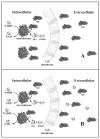Evidence for significantly enhancing reduction of Azo dyes in Escherichia coli by expressed cytoplasmic Azoreductase (AzoA) of Enterococcus faecalis
- PMID: 19663804
- PMCID: PMC5898631
- DOI: 10.2174/092986610791112701
Evidence for significantly enhancing reduction of Azo dyes in Escherichia coli by expressed cytoplasmic Azoreductase (AzoA) of Enterococcus faecalis
Abstract
Although cytoplasmic azoreductases have been purified and characterized from various bacteria, little evidence demonstrating that these azoreductases are directly involved in azo dye reduction in vivo is known. In order to evaluate the contribution of the enzyme to azo dye reduction in vivo, experiments were conducted to determine the effect of a recombinant cytoplasmic azoreductase (AzoA) from Enterococcus faecalis expressed in Escherichia coli on the rate of metabolism of Methyl Red, Ponceau BS and Orange II. The intact cells that contained IPTG induced AzoA had a higher rate of dye reduction with increases of 2 (Methyl Red), 4 (Ponceau BS) and 2.6 (Orange II)-fold compared to noninduced cells, respectively. Metabolites of Methyl Red isolated from induced cultures were identified as N,N-dimethyl-p-phenylenediamine and 2-aminobenzoic acid through liquid chromatography electrospray ionization tandem mass spectrometry (LC/ESI-MS/MS) analyses. In conclusion, our data demonstrate that AzoA from Ent. faecalis is capable of increasing the reduction of azo dyes in intact E. coli cells and that cytoplasmic azoreductase is involved in bacterial dye degradation in vivo.
Figures




Similar articles
-
Purification and identification of an FMN-dependent NAD(P)H azoreductase from Enterococcus faecalis.Curr Issues Mol Biol. 2009;11(2):59-65. Curr Issues Mol Biol. 2009. PMID: 18791262
-
Identification of Enterococcus faecalis enzymes with azoreductases and/or nitroreductase activity.BMC Microbiol. 2017 May 25;17(1):126. doi: 10.1186/s12866-017-1033-3. BMC Microbiol. 2017. PMID: 28545445 Free PMC article.
-
Molecular cloning, overexpression, purification, and characterization of an aerobic FMN-dependent azoreductase from Enterococcus faecalis.Protein Expr Purif. 2004 Apr;34(2):302-10. doi: 10.1016/j.pep.2003.12.016. Protein Expr Purif. 2004. PMID: 15003265 Free PMC article.
-
Recent advances in azo dye degrading enzyme research.Curr Protein Pept Sci. 2006 Apr;7(2):101-11. doi: 10.2174/138920306776359786. Curr Protein Pept Sci. 2006. PMID: 16611136 Free PMC article. Review.
-
Remarkable diversification of bacterial azoreductases: primary sequences, structures, substrates, physiological roles, and biotechnological applications.Appl Microbiol Biotechnol. 2019 May;103(10):3965-3978. doi: 10.1007/s00253-019-09775-2. Epub 2019 Apr 3. Appl Microbiol Biotechnol. 2019. PMID: 30941462 Review.
Cited by
-
Toxicological significance of azo dye metabolism by human intestinal microbiota.Front Biosci (Elite Ed). 2012 Jan 1;4(2):568-86. doi: 10.2741/e400. Front Biosci (Elite Ed). 2012. PMID: 22201895 Free PMC article. Review.
-
Probing the NADH- and Methyl Red-binding site of a FMN-dependent azoreductase (AzoA) from Enterococcus faecalis.Arch Biochem Biophys. 2012 Apr 15;520(2):99-107. doi: 10.1016/j.abb.2012.02.010. Epub 2012 Feb 24. Arch Biochem Biophys. 2012. PMID: 22387379 Free PMC article.
-
Differential gene expression in Staphylococcus aureus exposed to Orange II and Sudan III azo dyes.J Ind Microbiol Biotechnol. 2015 May;42(5):745-57. doi: 10.1007/s10295-015-1599-4. Epub 2015 Feb 27. J Ind Microbiol Biotechnol. 2015. PMID: 25720844 Free PMC article.
-
Evaluation of impact of exposure of Sudan azo dyes and their metabolites on human intestinal bacteria.Anaerobe. 2012 Aug;18(4):445-53. doi: 10.1016/j.anaerobe.2012.05.002. Epub 2012 May 23. Anaerobe. 2012. PMID: 22634331 Free PMC article.
-
Potential of halophiles and alkaliphiles in bioremediation of azo dyes-laden textile wastewater: a review.3 Biotech. 2024 Sep;14(9):194. doi: 10.1007/s13205-024-04036-0. Epub 2024 Aug 7. 3 Biotech. 2024. PMID: 39131176 Review.
References
-
- Chung KT. The significance of azo-reduction in the mutagenesis and carcinogenesis of azo dyes. Mutat Res. 1983;114:269–281. - PubMed
-
- Moller P, Wallin H. Genotoxic hazards of azo pigments and other colorants related to 1-phenylazo-2-hydroxynaphthalene. Mutat Res. 2000;462:13–30. - PubMed
-
- Golka K, Kopps S, Myslak ZW. Carcinogenicity of azo colorants: influence of solubility and bioavailability. Toxicol Lett. 2004;151:203–210. - PubMed
-
- Platzek T, Lang C, Grohmann G, Gi US, Baltes W. Formation of a carcinogenic aromatic amine from an azo dye by human skin bacteria in vitro. Hum Exp toxicol. 1999;18:552–559. - PubMed
Publication types
MeSH terms
Substances
Grants and funding
LinkOut - more resources
Full Text Sources
Research Materials
Miscellaneous

